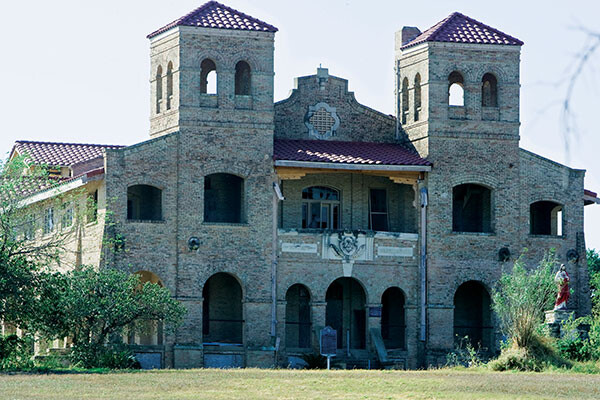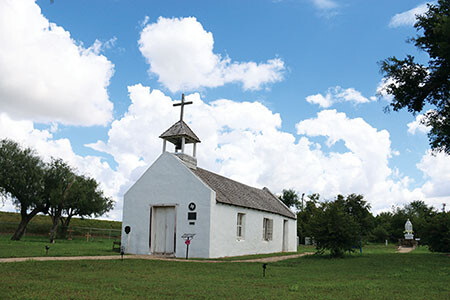 From Mission’s humble start as a mission with a small chapel, the city has grown to include several churches that have been around now since its inception as a city.
From Mission’s humble start as a mission with a small chapel, the city has grown to include several churches that have been around now since its inception as a city.
The City of Mission was practically a dry wasteland area that missionaries came upon over 100 years ago. It included large farms and ranches that covered the area. Some communities had as few as two to three families, where others had as many as 150 people.
It was in late 1849 that the first three Oblate Fathers answered a call to serve the Rio Grande Valley. They arrived in Port Isabel on December 3rd. They made their trek from the port, through a young City of Brownsville, before making their way along the Rio Grande River.
Because of the success of the three missionaries, Bishop Odin, visited France, Italy, Germany, and Ireland in hopes of recruiting more priests to serve the Texas mission. He did tell those he addressed, that they would lead the life of a true missionary in South Texas.
Those Oblate priests who came to the Valley came to be known as the “Cavalry of Christ” because they travelled on horseback from ranch to ranch, braving border clashes, bandits, the Civil War, a yellow fever epidemic and other harsh conditions.
They rode horseback, often for days without seeing another person. They traveled along the river to the ranches performing marriages, baptizing children, speaking over grave sites to bless the newly departed and teaching the Word of God to the families who lived on the ranches. They rode through scrub brush filled with long thorns and cactus. They never dismounted in the little towns and ranches until they were invited into the community.
Churches these priests, seminarians, brothers, and sisters built between Brownsville and the upper Valley remain today. They dot the landscape, and the voices can still be heard in those buildings.
Because of these priests, in Mission you will find the La Lomita Chapel still standing today. La Lomita, Spanish for “little hill,” is the location of the first settlement in the area of Mission, the place where Catholic priests frequently stopped to rest during their long, arduous horseback journey along the banks of the Rio Grande from Brownsville to present-day Roma.
Historical accounts are contradictory as to the date La Lomita Chapel was constructed by the Catholic priests. According to one account, the chapel was built in 1899; another says it was first built at another site in 1865 then relocated to the present site. They built not just the Chapel, but also small cottages, a warehouse for provisions, and a store. There was also a 60 square foot plaza on the grounds. All but the chapel were destroyed during a hurricane.
Nonetheless, it is known that the chapel became part of a project turning the former ranch into headquarters for Oblate priests, who rode along the river from Brownsville to Roma spreading Christianity and serving the people on the ranches bordering the river.
The chapel is located about halfway between Brownsville and Roma, which is a distance of 120 miles on the current expressway but was 300 miles when traveling along the curves and bends in the river.
The La Lomita stood on a huge parcel of land. John Conway and James Hoit later bought 17,000 acres of the land for the development of the original town site of Mission. The City of Mission was named for the chapel.
********
Conway is credited with being the founder of Mission. He came to the Rio Grande Valley in 1906. After visiting the Valley, he saw the potential for development and stayed to help make it happen. He and Hoit, were able to purchase the land for $9 an acre. He also purchased another 10,000 acres from John Closner and J.B. Wells.
Conway-Hoit would clear and ready the land for agriculture and then sell it for $40 to $50 an acre. They sold the farmland in 40-acre tracts to farmers from the Midwest that were planning to relocate to Texas. Conway had planned the development of the townsite with alleys for garbage pickup, schools, churches, and libraries.
Even though he was Catholic, he donated land to establish the Methodist, Baptist, and Presbyterian churches. These can all be found on Doherty Avenue in Mission. (You will find Spanish speaking ones on the south side of the tracks, and predominately English-speaking churches on the north side.) He was also one of seven that organized the First State Bank.
They began construction of canals and a pumping plant to help with the booming agriculture of the area. Crops such as sugarcane, wheat, cotton, and corn were becoming fruitful. But it was not too long before Mission was being advertised as “The Home of the Grapefruit” in posters advertising why people should come to the Valley – the “Garden of Eden.”
********
John Shary is known as the Father of the Citrus Industry. On a coin toss when visiting the Valley, he decided to stay and pursue his dream of creating a citrus industry in South Texas. He saw untouched brush land ready for development.
He started developing over 300,000 acres of land and made a mission to attract more settlers to the area.
Seeing that the soil was fertile, Shary started growing citrus. He studied the soil, how citrus was grown in other areas, and developed his own method in the Valley.
He eventually built the Texas Growers Exchange to market all the citrus fruit grown in the Valley. Shary coined the name TexaSweeet – a brand that can be found in your produce sections still today.
By 1924, there were two million trees in grapefruit production and another million ready to be planted.
Shary built a large home in what is now Palmhurst, on Shary Rd and Three Mile. The home is still surrounded by citrus trees.
Because of Shary, we celebrate grapefruit, and other citrus, as part of Mission heritage with the Texas Citrus Fiesta. Texas Citrus Fiesta events are held throughout the year with the largest event, the parade, being held in late January.
To find out more about the City of Mission, visit https://missiontexas.us/. The Mission Historical Museum (previously the Shary Building) can be seen at https://missionmuseum.org/. The museum features exhibits from the past, a wall and room honoring veterans of the community, and rotating exhibits that share the history of the City of Mission.













